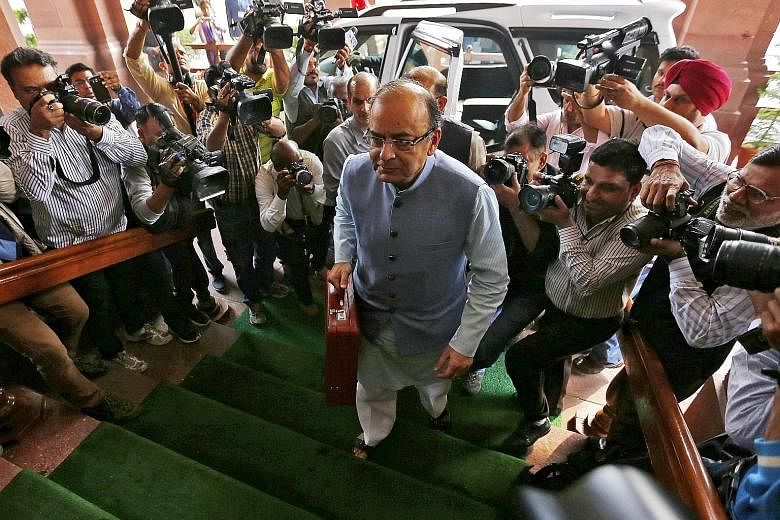India's Finance Minister Arun Jaitley has unveiled a farmer-friendly Budget focused on improving the rural economy while increasing government spending on welfare, ahead of local elections in five states. It signalled a marked shift by a government that has been seen as corporate-friendly.
Mr Jaitley presented his third Budget in Parliament yesterday, expressing optimism that India would weather the global downturn and saying providing for "vulnerable sections" of society remained a priority.
He announced a big funding increase for the national rural employment guarantee scheme to 385 billion rupees (S$8 billion) in the fiscal year starting April 1 this year to March 31 next year, up from 346 billion rupees in the previous year; electricity for all villages by 2018; and 190 billion rupees in the new fiscal year for rural road development - all aimed at increasing rural employment. The government has also promised to double farmers' income in the next five years.
-
Budget at a glance
-
2015-2016 ACHIEVEMENTS
• Gross domestic product (GDP) growth of 7.6 per cent
• Decline in inflation to 5.4 per cent
• Reduction of current account deficit from US$18.4 billion (S$25.8 billion) to US$14.4 billion
• Foreign exchange reserves highest ever at US$350 billion
-
2016-2017 TARGETS
• Revenue receipts of 13.77 trillion rupees (S$284 billion), a 14 per cent increase from 2015-2016
• Total expenditure of 19.79 trillion rupees, up 10.8 per cent from 2015-2016
• Fiscal deficit of 3.5 per cent in 2016-2017, down from 3.9 per cent in 2015-2016
• Lower revenue deficit target of 2.5 per cent, compared with 2.8 per cent in 2015-2016
• Invest 2.21 trillion rupees in infrastructure; of this, 2.18 trillion rupees is earmarked for roads and railways
-
LONG-TERM GOALS AND PROGRAMMES
• Double farmers' income by 2022
• Electrify 100 per cent of villages by May 1, 2018
• Provide liquefied petroleum gas connections to 15 million households below poverty line in 2016-2017, to be increased to 50 million in the following two years
• Promote digital literacy in another 60 million households in the next three years through New Digital Literacy Mission
• Launch new health protection programme providing a cover of 100,000 rupees per family, with an additional top-up of 30,000 rupees for senior citizens
"The priority of our government is clearly to provide additional resources for vulnerable sections, rural areas, and social and physical infrastructure creation," said Mr Jaitley, who also noted that "risks of further global slowdown and turbulence are mounting".
"This complicates the task of economic management for India," he said, adding: "Since foreign markets are weak, we must rely on domestic demand and Indian markets to ensure that India's growth does not slow down."
The government of Prime Minister Narendra Modi came to power in 2014 promising to spur economic growth by promoting manufacturing and infrastructure spending. In the last Budget, the government cut spending on some social programmes to free up funds for building infrastructure, but restored some of this after criticism.
Mr Modi has also faced accusations of ignoring the farming sector in previous Budgets even as the agriculture sector is going through tough times due to consecutive droughts, with reports of farmer suicides and a fall in rural consumption.
Agriculture grew by below 2 per cent in recent years though the economy is predicted to grow by between 7 per cent and 7.75 per cent in the new fiscal year.
Yesterday, Mr Modi sought to remove the impression that his government was farmer-unfriendly and focused on helping companies.
"This Budget is aimed at removing poverty...The farmers are the biggest focus of this year's Budget," he said in a televised address.
Overall, industry bodies and analysts gave the thumbs-up to the Budget, calling it a good balancing act between fiscal prudence and spending on the rural economy and welfare schemes.
"There was nothing spectacular but it (the government) did all the right things and the Budget ticked all the right boxes. Rural revival is a positive," said Mr Shivom Chakravarti, senior economist at HDFC Bank in India.
Still some companies said more attention should have been given to the manufacturing sector even as the rival Congress party called it a "wasted opportunity".
"There is no new idea... There is no major initiative to increase productivity of crops," said former finance minister and Congress leader P. Chidambaram.
The fiscal deficit target was set at 3.5 per cent of gross domestic product, down from 3.9 per cent in the current fiscal year.
Some see the Budget as being aimed at winning state elections.
It has been designed to ward off criticism from the Congress party that the ruling Bharatiya Janata Party "is a party only for the rich and has nothing for the common man", said Mr Rishi Sahai, managing director of investment bank Cogence Advisors. "It (the Budget) will help them in the elections, as it will put money in the hands of farmers and the rural community."

